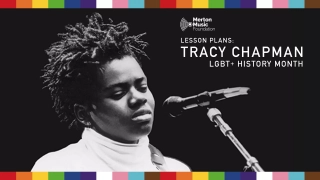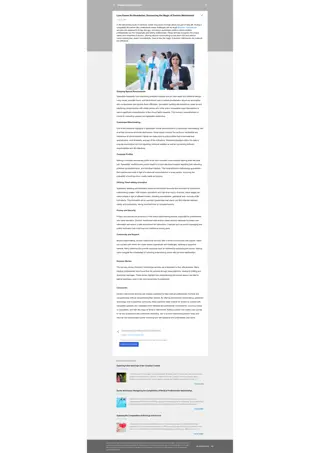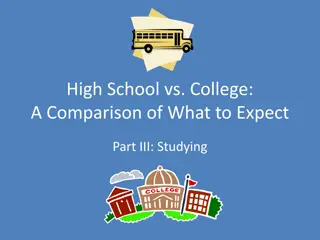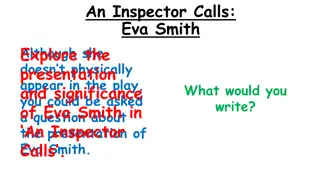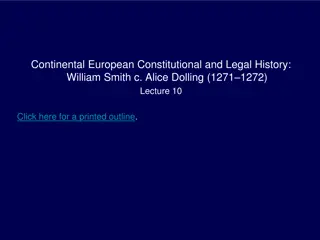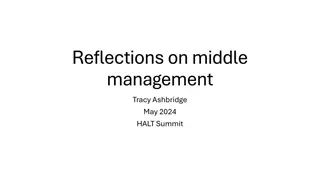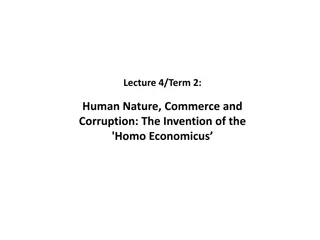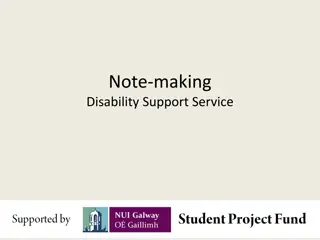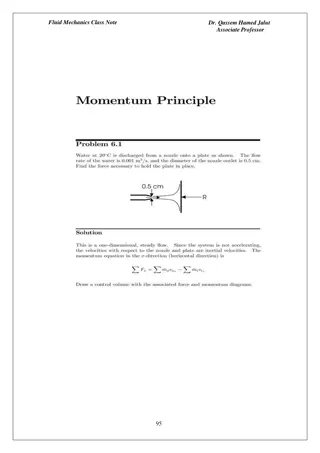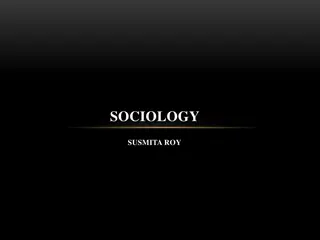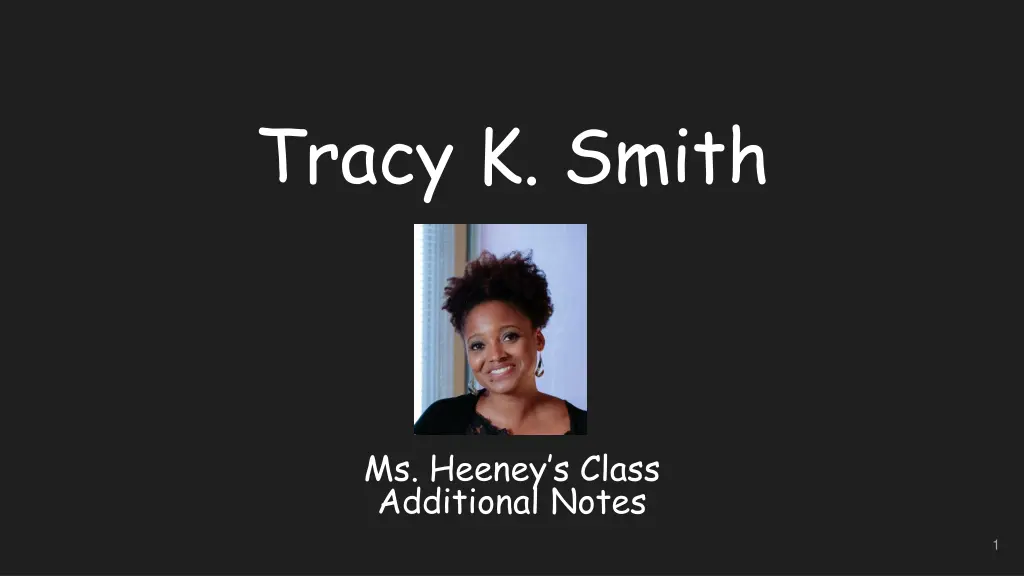
Tracy K. Smith: Power of Poetry and Personal Journey
Explore the life and influences of Tracy K. Smith, the newly named U.S. Poet Laureate. Discover how her childhood, family, and experiences shaped her poetry, blending spirituality and science. Uncover her inspirations like Emily Dickinson and Seamus Heaney, and the impact of personal losses on her work.
Download Presentation

Please find below an Image/Link to download the presentation.
The content on the website is provided AS IS for your information and personal use only. It may not be sold, licensed, or shared on other websites without obtaining consent from the author. If you encounter any issues during the download, it is possible that the publisher has removed the file from their server.
You are allowed to download the files provided on this website for personal or commercial use, subject to the condition that they are used lawfully. All files are the property of their respective owners.
The content on the website is provided AS IS for your information and personal use only. It may not be sold, licensed, or shared on other websites without obtaining consent from the author.
E N D
Presentation Transcript
Tracy K. Smith Ms. Heeney s Class Additional Notes 1
For newly named U.S. poet laureate, the power of poetry is opening ourselves to others 2
Art Works Podcast: a conversation with Tracy K. Smith about poetry, history, memory, and wonder 3
Studied Poems : 1. Joy 1. Letter to a Photojournalist Going-In 1. The Universe is a House Party 1. It s Not 1. The Greatest Personal Privation 1. Ghazal 4
Biographical Details Tracy K. Smith was born on 16 April 1972 in Falmouth, Massachusetts. The youngest of five children, she was known to the rest of the family as Kitten . Shortly after she was born, the family moved to Fairfield, California. Smith s father, Floyd, who later worked on the Hubble Space Telescope, was an engineer at the nearby Travis Air Force Base. Smith s mother, Kathryn, worked for a while as an adult education teacher but largely devoted herself to her family, church and community. Smith grew up in comfortable surroundings and received a great deal of attention from her parents when she was learning to read and write. Indeed, language was to form a particularly strong link between the young Smith and her devoted mother and father. Smith s childhood home was a place where both religious faith and scientific curiosity were strongly present. Kathryn Smith was a devout Christian, but her belief expressed itself far more in terms of trust in God than in any kind of dogmatism or anger. Floyd tended to focus instead on the power of science and on life in this world. At one point, for example, he installed an incubator in their home so that Smith could learn about how birds were hatched. It is perhaps little wonder that tensions and connections between spirituality and science would be explored so often in the poetry that Smith would later write. 5
Smiths school teachers soon spotted her budding literary skills and encouraged her to fully develop them. Another important early event was Smith s first encounter with the poetry of Emily Dickinson, who was to remain a major influence throughout Smith s literary career. In her memoir, Ordinary Light, Smith vividly recalls the sudden flash of recognition that she felt when she first read Dickinson s poem I m Nobody! Who Are You? She recalls feeling that somehow Dickinson knew more about her than she did herself. That aside, Smith valued Dickinson for her highly original use of biblical cadences and her daring ability to coin new words and phrases. Another kindred spirit is Elizabeth Bishop who, like Smith, uses relatively plain, down-to-earth language to explore the infinite, the uncanny and the mysterious in everyday life. Other key influences include Irish poet Seamus Heaney, who was one of Smith s teachers at Harvard University; the humorous writings of Mark Twain; and Smith s fellow African American poets Rita Dove and Yusuf Komunyakaa. In 1994, Smith experienced a life-changing bereavement when her mother died of cancer just after Smith had graduated from Harvard University with a degree in English and Afro- American Studies. Typically, the devout Kathryn viewed these terrible events as ultimately part of God's plan. Smith felt another kind of loss when her father began seeing another woman. How would these feelings of grief and abandonment shape her poetry? Essentially, Smith took vital elements from both parents and interwove them in her poems. From her scientist father, she learned how to observe and be precise in her descriptions. From her Christian mother, she inherited and retained a strong sense of wonder and spiritual grace. 6
In 1997, Smith was awarded an M.F.A. (Master of Fine Arts) degree by Columbia University. Between 1997 and 1999, Smith served as a Stegner Fellow (lecturer and researcher) in poetry at Stanford University. In 2003, Smith published her first volume of poetry, The Body's Question. This was followed by two further collections, Duende (2007) and Life on Mars (2012). All three collections received very positive reviews. Smith was praised in particular for her ability to move skilfully from everyday events to much larger issues. Critics and other readers celebrated Smith's ability to find a place for mystery and the incomprehensible within 'ordinary life'. The poems in Smith's fourth collection, Life on Mars (2012), displayed many moods, addressing everything from the poet's grief at the death of her father in 2008 to the relative significance of human beings within the universe. In her memoir Ordinary Light (2015), Smith investigated the key elements that had shaped her identity, including the early loss of her mother and her increasing consciousness of her African American heritage. In 2018 Smith published her fourth poetry collection, Wade in the Water, which explores issues of class, climate and slavery. In this collection Smith makes extensive use of found texts written by others. 7
Having previously taught at the University of Pittsburgh, the City University of New York and Columbia University, Smith joined the faculty at Princeton University in the mid-2000s. She was appointed director of Princeton's writing programme in 2015. In 2017, the Library of Congress announced that Smith had been chosen as its new poet laureate, one of highest honours that a poet can receive in the United States. Smith served as laureate until 2019. As poet laureate, Smith tried to spread awareness of poetry by visiting small towns and rural locations and holding literary events. Although Smith often addresses social and political issues in her poems, she was more interested in using her laureateship to promote public understanding of poetry itself. She has said that her main objective as laureate was 'to give more readers access to more kinds of poems and poets'. Smith has also tried to further this objective by hosting the five- minute weekly podcast The Slowdown, in each episode of which she reads and briefly discusses a poem she has chosen. Among the many awards and prizes that Smith has received are the James Laughlin Award (for Duende), the Pulitzer Prize for Poetry (for Life on Mars) and the National Book Award for Nonfiction (for Ordinary Light). As all of her varied undertakings and interests strongly suggest, Smith sees herself not only as a working poet but also as a kind of ambassador for poetry in the wider world. Smith was appointed chancellor to the Academy of American Poets in 2021. In the same year she was elected to the American Academy of Arts and Letters, a lifetime appointment. Election to the academy is considered the highest form of recognition for an artist in the United States. In 2021, after sixteen years of working in Princeton, Smith moved to Harvard to become Professor of English and American and African-American Studies. Although Smith is one of the most important and influential poets working in America today, in person she is quietly spoken, open and friendly. In her work, she is fearless and ambitious, and she continues to develop new work. In 2022, the Cincinnati Opera will premiere Castor and Patience, for which Smith wrote the libretto. The opera tells the story of two Black cousins fighting over land they have inherited in the American South. She currently lives in Massachusetts with her husband, daughter and twin sons. 8
Social and Cultural Context That Tracy K. Smith is an African-American woman is key to understanding the influence of the social and cultural context upon her life. It is interesting to note that 1972, the year of Tracy K. Smith's birth, was the year when the Equal Rights Amendment was passed. The amendment gave equal rights to men and women. Before this time, women were treated as second-class citizens in areas such as education, divorce, child custody and employment. However, the main influence on Tracy K. Smith's work is the fact that she is a Black woman who grew up in the United States. As a Black woman, she has a critical view of the development of the American state, with its history of slavery, oppression and inequality. Her mother and father both grew up in Alabama during the period when state laws enforced segregation, and where racism was evident in everyday life. Her parents placed enormous value on education, believing it would create social opportunities for their children. Despite her father's experience of segregation, he was patriotic in a way that puzzled his daughter. Smith grew up in a largely white community in Fairfield. However, race did intrude on her childhood. Her parents encouraged their children to succeed, while believing that they would have to be twice as good as white people in order to do so. 9
Smith says that, from the age of ten, she lived with the vague knowledge that pain was part of her birth right, a pain her adult self understood to have been borne by the people she loved, a pain 'that was tied up in blood in race, in laws and war... laws that had sought to make people like them - like us, like me subordinate . She has said, 'I don't think we ever truly forgot about whites, even when we were alone among ourselves in the thick of family.' When the Black Lives Matter movement was established in 2013, it sought to highlight police brutality and the systematic racism directed towards the Black community. The death of George Floyd in May 2020 confirmed for many, including Tracy K. Smith, that the country needed to confront the inequality and racism that divided it. They saw the Black Lives Matter protests as following the footsteps of the civil rights campaigns of the 1950s and 1960s. As far back as 1968, presidential commission, which was established to investigate civil unrest and the deaths of forty- three people in protests and riots in Detroit, and a further twenty-three in Newark, found that 'bad policing practices, a flawed justice system, unscrupulous consumer credit practices, poor or inadequate housing, high unemployment, voter suppression and other culturally embedded forms of racial discrimination all converged to propel violent upheaval'. The commission recommended that the government should spend money aimed at creating equal opportunities for the Black community. The findings of the commission were largely ignored, and in the following year the government invested vast sums in space travel. The day after the 1969 moon landing, a leading Black newspaper ran the headline: 'Yesterday, the moon. Tomorrow, maybe us.' Since 1968, the situation for the Black community has worsened, with higher rates of unemployment, higher rates of imprisonment and an increasing wealth gap between white families and Black families. 10
Smith has spoken about the challenge, as a teacher, of encouraging open and honest conversations about the issues that confront the nation. Smith sees poetry as one way of exploring the racial trauma experienced by what she calls 'the community of blackness'. In Wade in the Water (2018) and Such Color (2021), the social and cultural contexts shape the books in profound ways. Both books explore ancestry and race. They confront America's shameful history of racism and its contemporary manifestations, while offering a vision of poetry as a healing art. Writing in 2020, Smith observed: 'I spent the summer of 2020 worried, bothered, and gripped by uncertainty... How long would violence against unarmed Black citizens continue to claim lives? How far off were things like justice, safety, accountability, equity, truth?' 11
Poem 1: Joy 12
Joy - Notes This poem is set in 1994, at a time when the poet's mother is terminally ill with cancer. The mother, for now, is still being cared for in a hospital in the southern state of Alabama. The poet, a student at Harvard University, has taken a break from her studies and has travelled to Alabama to be by her mother's side. The mother, we quickly realise, is in a greatly weakened state. She seems unable to leave her bed. It seems that she is perpetually cold. It is summer in the American south, meaning that the weather is extremely hot. But her carers have still 'covered' her with a quilt to keep her warm. It seems that she is unable to tolerate bright lights. Even direct sunlight, it seems, distresses her and induces a headache. Her carers, therefore, ensure that her room is always kept dark. The poet realises that her mother is gradually getting sicker. "Soon' her body will be hooked up to a set of 'transparent tubes', which will introduce various substances into her system. One tube might be used to deliver oxygen. Another might deliver nutrients. Yet another might be used for chemotherapy drugs. The phrase 'traffic/ Of transparent tubes' is suggestive in a metaphorical sense. It brings to mind both the movement of vehicles and the transportation of goods, presenting the tubes as relentlessly busy highways along which substances are always moving. The term 'traffic', of course, also suggests a supply of materials that are dangerous or illegal, suggesting that at least some of the substances pumped into the mother's body will have negative side effects. 13
The mother's body, it is implied, is eager to take care of itself. It wants to perform all the functions necessary to keep itself alive. But her body, in its weakened state, will have to compromise with these 'transparent tubes'. It will have to allow technology to perform at least some of these vital functions. It's noteworthy that the tubes, rather than the mother's body, are depicted as 'striking' this compromise. Medical technology, then, is the more active partner in the compromise, suggesting that the mother, as her health worsens, will become ever more powerless and diminished. We can imagine the poet sitting by her mother's bedside, the two of them conversing and reminiscing. The mother, no doubt inspired by this present hospital stay, remembers 'Playing hospital' when she was a child. She focuses on a particular game of hospital that occurred when she was nine years old. The mother, it seems, pretended to be a patient, while her sisters pretended to be doctors and nurses. The mother recalls how she took a 'handful' of raisins, which were one of her favourite foods, and placed them in her mouth, pretending that they were medicinal tablets: 'These will be my medicine'. 14
The mother's body is in such a weakened state that she experiences very few appetites and desires. But she does get a craving for a meal of 'dumplings and kale'. She listens to her body, 'Trusting' this one remaining 'need' or appetite, and asks the poet to prepare this 'simple meal' and bring it to the hospital. This meal, it seems, was one the mother associates with her childhood long ago. Indeed, the mother, we're told, is 'Imagining [herself] a girl again' when she makes this request. Perhaps the mother, in her distress, longs for some comfort food that reminds her of childhood and happier times. Or perhaps the mother, in her helpless state, feels like a child once more and thought it appropriate, therefore, to have food she associates with being a child. This phrase, of course, also suggests the role reversal that has taken place between the poet and her mother. Once it was the mother who cooked for and looked after the poet. But now the opposite is the case. Kale, it is worth noting, is one of the most nutrient-dense foods on the planet. The kale, then, will function as real medicine for the mother's battling body, just as the raisins functioned as pretend medicine all those years ago. The mother, we're told, 'savours' the kale and dumplings, eating slowly and with great enjoyment. However, she is unwilling or unable to finish her meal. It's as though she realises that her body, in its weakened state, would be incapable of digesting everything on her plate. 15
The poet watches as her mother closes her eyes and dozes on her hospital bed. The mother, she imagines, is visualising a dark and closed space with a light at its centre. There are several ways to interpret this image of light and darkness. Perhaps the 'chamber' is the hospital room, which, as we noted above, has been darkened, while the 'light' represents the mother lying at the centre of the room on her bed. Perhaps the 'chamber' represents the body, while the 'light' represents the immortal soul that lies at the body's centre. Or perhaps the dark 'chamber' represents eternity, while the 'light' at the centre represents human life. This reminds us of the brevity of human existence, reminding us that each human life is only a flicker of light amidst the darkness of eternity. Here Smith uses a technique known as synaesthesia, which occurs when something associated with one sense is presented in terms of a different sense. Here darkness and light, usually associated with the sense of vision, are associated with the sense of sound. The mother, we are told, is listening to the darkness, while the light is depicted as a 'chord', which is a set of musical notes played simultaneously. This use of synaesthesia gives us the impression that the mother is utterly focused on this image of light and dark, and is meditating on it with her entire being. 16
Main Themes Key Features Love Loss Grief Letting Go A Search for Meaning Identity Memory Time Imagery - Contrasting Images Metaphors Anecdote Alliteration Run On Lines Rhetorical Question Sibilance Sensuous Language Varying Tones Juxtapositioning Synaesthesia 17
Letter to a Photojournalist Going - In - Notes In this poem, Smith addresses a friend of hers who works as a photojournalist, a reporter whose journalism takes the form of pictures rather than words. This particular photojournalist, we quickly learn, spends much of his time reporting from war zones around the world. His life, then, is one of constant travel. He journeys to remote regions that can only be reached by days of uncomfortable travel on a bus or in a truck. And everywhere he visits is a war zone, everywhere he ends up he sees death, violence and destruction. The poem takes the form of a letter written to the journalist, at a time when he is 'Going In', heading off on assignment. There are many times, during his travels, when the photojournalist is subjected to abuse and intimidation. The borders he crosses, for instance, are often manned by soldiers who peer 'into [his] eyes' in a most intimidating manner, a manner that suggests they'd simply like to erase' him. These soldiers, no doubt, view the photojournalist with intense mistrust. They don't like the idea of this photographer recording their activities and behaviour. The photojournalist, of course, frequently finds himself in districts where two opposing sides are locked in a bitter dispute. Soldiers from one side or the other often challenge the photojournalist about his attitude to such conflicts, taking him to one side and asking him which side he believes is in the right. For obvious reasons, of course, this might be a dangerous question for the photojournalist to answer honestly. 19
Sometimes soldiers actually assault the photojournalist. Sometimes they 'throw [him] in a room' and interrogate him. Perhaps, on these occasions, the soldiers in question genuinely think the photojournalist is a spy. Or perhaps they are angered by something the photojournalist says or does. The photojournalist, it seems, has learned to put up with such abusive behaviour. He seems confident on these occasions that he won't be beaten too badly or detained for too long, that he will soon be able to continue with his reporting. Everywhere the photojournalist goes, of course, he witnesses the horrors of war. Smith uses a striking image to capture these horrors, depicting war as a 'strong fist' that slowly hammers person after person' into the ground. This powerfully captures the terrible effect of war on those unfortunate enough to live in conflict zones, suggesting how they are ground down slowly by violence, fear and deprivation. The photojournalist, we're told, finds himself 'taking it' when he witnesses these horrors. It's as if he's learned to accept these brutal realities, realising, no doubt, that there's little he can personally do to change things. The poet describes some of the images captured by the photojournalist when his camera blinks'. He photographs soldiers casually enjoying a smoke in between 'rounds' or bouts of fighting. He photographs bodies that have been blown apart by gunfire or explosions. He photographs young boys who imitate the grown-up soldiers that surround them. These youngsters proudly display their toy 'plastic guns' as if they were victorious fighters posing for the television news. 20
These terrible events haunt the photojournalist's dreams. He dreams that explosions magically reverse themselves, the debris and wreckage reforming into a building once again. During the day the photojournalist photographs victims who ran away screaming from bombs or gunfire. He dreams that these images come to life and reverse themselves. The victims' mouths close as they stop screaming. They run backwards out of the photograph's frame, returning to their homes or offices that are suddenly safe again. The photojournalist, it seems, is someone who keeps things bottled up. He rarely speaks about the horrors he witnesses, or about the effect these experiences have on his psyche. One night, however, he makes a phone call to the poet and shares this secret knowledge, opening up about his trauma. The poet is listening the photojournalist speak when she hears a strange noise in the background. She quickly realises that the photojournalist's location is coming under attack by missiles. The missiles make a shrill whistling sound as they fly through the air and an incredibly loud thudding sound when they strike their targets. For a moment, the poet imagines that these missiles resemble stars as they hover in the sky above the city. But these, alas, are Errant stars', stars that have gone astray and are falling down to Earth. And when they fall to Earth they flare and shatter, causing untold destruction. 21
The poet, after such conversations, finds it difficult to believe in love or to even say the word 'love'. She is overwhelmed by the realisation that everything in life is destined to eventually be destroyed. And this knowledge argues or 'pushes back' against the very concept of love. She begins to feel that there is no dignity, no higher purpose to her work, to the work of the photojournalist, or any human activity. After such conversations, the poet even finds her trust in humanity falling away. Trust, she feels, is just some human trick' that will inevitably lead to betrayal and disappointment.The poet sketches what she imagines to be the mentality of the photojournalist. People like the photojournalist deliberately go to the pain, travelling to sites of suffering that most of us would eagerly avoid. The poet suggests that the photojournalist was desperate to 'lose everything', to shake off the comforts and commitments of everyday life. His globe-trotting duties mean that he can't have children, long-term relationships or even a permanent place of residence. He lives without the routines and commitments of ordinary existence, but also without its comforts and joys. The poet suggests that the photojournalist is utterly committed to the truth. He is determined to witness and record the true brutality of humanity, no matter the cost to his own well-being. There are moments when the poet thinks the photojournalist's philosophy of life is correct. There are moments when she wants her heart to beat like that of the photojournalist, to emulate the photojournalist's emotions and psychology. She wants, like him, to be fearless but cynical, truthful but bleak. There are moments when she too wants to lose everything, to live a life free from convention and commitment. The poet especially wants to confront the reality of time, to unflinchingly address its destructive nature. The poet uses a wonderfully vivid simile to describe this impulse, saying that she wants time to land' like 'a grenade' at her feet. The poet then is determined to see time not as an abstract or philosophical concept, but as a potent and destructive weapon. 22
Key Themes Search for Meaning Love and Relationships War and Violence Human behaviour 23
Key Features Punctuation eg borders flows rather than closed by punctuation mark Alliteration Internal rhyme - shatter, matter Richly textured Written in free verse Enjambment throughout Narrated in second person- makes reader feel they are being personally addressed-draws reader in Repetition city after city Verbs - peer, erase - powerful Personification Ambiguous imagery eg line 18/19 Sibilance Vivid imagery Euphonious lines Variety of tones Use of 6 questions which are a trademark of Smith s poetry 16 unrhymed couplets with 2 single line stanzas - one of which concludes the poem Straightforward language but complex questions posed Similes Adjectives conjure ideas eg insincerity..empty,hollow Militaristic and violent language Staccato lines open Juxtapositioning 24
The Universe is a House Party - Notes This is one of several poems where Smith takes inspiration from scientific thought. This poem's opening deals with the theory, explored by scientists since the 1920s, that 'The universe is expanding'. Smith plays with this idea, imagining that everything around us is moving outward, is drifting invisibly but steadily towards the limits of creation.This drift applies to invisible phenomena like radio waves. Smith, for instance, imagines all the radio waves that were emitted by human technology a 'generation ago', coming from radar systems, from wireless computer networks or from ordinary radio stations that broadcast pop tunes and news items. She imagines that these waves, having served their purpose, passed beyond the earth's atmosphere. For about twenty years now, they have been travelling through the void of space. And they will continue on this journey for centuries or millennia until they reach the edge of the universe itself. But this drift also applies to ordinary physical objects. Smith imagines, for instance, a house party where the guests stay in the host's house for a whole weekend, partying night and day. She imagines the various items that might be present during such an event. She thinks of 'postcards' the host has received from around the world, that might be pinned to the apartment walls or to some kind of notice-board. She thinks of 'Orphan' socks and items of underwear that have been misplaced by their owners as the party goes on day after day. She thinks of empty discarded bottles that lie here and there around the house. 27
The partygoers, she imagines, have left lipstick stains on the rims of many of these bottles. She thinks of towels that have been used to mop up spillages. These towels, she imagines, have been wrung into knots and left to dry. All of these everyday items, just like the radio waves mentioned above, are 'Drifting' invisibly but inexorably towards the 'edge' of the universe itself. This radiation makes the universe what it is, influencing concepts such as gravity, energy and matter. It came into being at the very beginning of the universe, during the Big Bang, and will exist as long as the universe does. Smith wonders what this radiation might look like, if we could somehow capture it and make it visible to the human eye. 28
She suspects that it would be indescribably bright, so bright that our eyes would reflexively shut when exposed to its glare: 'Is it bright? Will our eyes crimp shut?" It might have the unbearable brightness of the flash associated with an 'atomic' or nuclear explosion. Its brightness might even be greater than that of a sun exploding in a 'conflagration', an all-consuming fire, as it goes supernova during the last stages of its existence. Smith also wonders what this radiation might sound like if we could somehow make it audible to the human ear. She imagines, in a rather surprising comparison, that it would resemble the noise of a house party taking place in a neighbour's apartment: It sounds like the kind of party/ Your neighbours forget to invite you to'. This radiation, if we could hear it, would have a deep and repetitive drone-like quality. It would resemble, therefore, the sound of techno or hip-hop music coming from such a party and 'throbbing' through the walls of the entire apartment building. It would also have a percussive drum-like quality, resembling the 'thudding' sound made by the party guests when they drunkenly venture on to the building's roof. For centuries human beings have used telescopes to study the stars. And in recent decades the lenses in our telescopes have become more and more refined, attaining a level of magnification that would have seemed 'impossible' or unimaginable to our ancestors. Smith describes how, as we look up at the stars, we find ourselves wondering about life on other planets. We can't help but 'dream of beings' that might exist out there in the universe. We even fantasise about these alien life-forms coming to visit us. 29
Smith, in an amusing flight of fancy, imagines us warmly welcoming these extra-terrestrial beings if and when they finally make it to planet Earth. We would greet them politely when they first arrive, telling them how 'marvellous' it is that they've come to visit us. We would be careful not to 'flinch' at their bizarre appearance. These visitors, as Smith imagines, might well have tiny 'pinprick eyes' and rather lumpy 'nubbin limbs' or other unusual features. But we would be sure not to give any indication that we find their appearance off-putting or disturbing. We would insist that our extra-terrestrial guests make themselves at home, using the famous Spanish expression Mi casa es su casa', which means 'my house is your house. We would treat them with a hospitality that is inexhaustible or 'indefatigable'. We would shower them with kindness and attention, showing them the best of what Earth has to offer. The human race, according to Smith, would 'rise' as we welcome our alien visitors, suggesting that these efforts would bring out the best in humanity. We would act in manner that is both strong and graceful. We would be more sincere', more honest and decent, than we had ever been before. 30
Key Themes Spirituality- Smith contemplates the universe with its all eternal vastness. We sense she is almost overcome by a sense of spiritual wonder as she considers the universe revealed to us by science Wonder of the natural world Human hubris Humanity's place among the cosmos 31
Key Features Title- metaphor 19 line poem 9 couplet and one stand alone Eclectic imagery Cinematic imagery Paradoxical imagery Use of dialogue Italics to emphases Smith trademark use of questions Similes Onomatopoeia Arresting alone line Varying tone Juxtaposition imagery Language straightforward but themes are not Interesting pattern sounds and repetition all through the poem. In first 4 line the explosive p and b are audible. In the opening lines the ck , sk , k are repeated and reappear in wonderful phrase - pinprick mouth Short emphatic statement opens the poem Staccato question Assonance Alliteration Enjambment Verbs- powerful eg look No rhyme scheme or metre but capital letter used at start of every line gives the poem a formal appearance Long lines allow for description, speculation and thought Use personal pronouns eg we , our - is intriguing - strengthens engagement with reader Use of present tenses adds immediacy Juxtaposition of cosmic and domestic imagery creates intriguing effects 32
Its Not - Notes The poem's opening features personification, which occurs when an abstract concept is presented as if it were a person. concept of death, in this instance, is presented as an individual who visits each of us when our lives are over, and leads us into the afterlife. The poet describes how this personification of death came for her own father when he passed away several years ago. By doing so, of course, Death caused great suffering to her father's loved ones. This included the poet herself and her sister Jean, to whom the poem is dedicated. It also included the father's second wife, who, no doubt, felt abandoned when her beloved husband passed away. The poet stresses, however, that Death did not inflict this suffering deliberately. It wasn't even thinking about her father's loved ones when it came for him: 'It's not/That death was thinking of you or me/ Or our family, or the woman/ Our father would abandon when he died.' Instead, Death was focused on the task at hand. It knew it needed to escort the father from this world to the next. Death, the poet suggests, knew that it owed the father the gift of dying. And it was determined to settle this debt or obligation: 'Death was thinking what it owed him'. This poem, then, presents an unusually positive view of death. Death is depicted as a 'ride', a thrilling final adventure that awaits us once we've finished with this life. It's a journey that took the father 'beyond' the body into some spiritual state, into a non-physical realm we cannot begin to comprehend. It's a journey that took him beyond the annoying, stressful aspects of life, such as the tax return forms he would have to fill out and return each year. But it's also a journey that took him beyond the pleasant, beloved aspects of life, such as the fruit trees that grew in garden. 35
The poet, in a playful flight of fancy, imagines Death escorted her father through an enormous supermarket. She imagines them passing through the hardware section with its 'aisles of tools' and the frozen food section that has a 'freezer lined with meat'. She imagines them passing a television showing an advertisement for one of the products available in-store. This advertisement, it seems, is playing a loop, repeating the same message 'over and over'. Here Smith seems to be commentating on the central role of consumerism in modern society. These TV advertisements are to us what prayers and Bible verses were to earlier generations. Smith quotes a famous verse from the Gospel of Matthew, "Seek// And ye shall find. But whereas our ancestors attempted to seek meaning in spirituality, nowadays we attempt to seek meaning in possessions and consumer goods. Perhaps this is why Smith imagines Death leading her father around a supermarket. Death, as the poet imagines it, believes that every human being is obsessed with consumerism and regards superstores as the greatest places on earth. The poet and her sister, it seems, have been insisting that their father has 'vanished'. They can't avoid thinking that death 'ran off with the father they loved so much. Death, they feel, has left them utterly bereft of the man they regarded as 'our/ Everything worth having', who meant more to them than anything in this world. The poet, however, suggests that she and her sister should consider their father's passing in a different light. They should stop thinking of him as having vanished. For while the father may have disappeared physically, he still exists spiritually. He is gone' only in the superficial sense that they can no longer see or touch him, can no longer easily 'tell' that he is around. But he still exists as a spiritual presence in their lives. 36
Key Themes Death - from an unusual perspective Grief / Loss Spirituality / Religion Science Love / Relationships Imagination 37
Key Features Poem has a thinking out loud quality Speaker asks questions, rhetorical questions about the way we think about death Whole poem has a questioning feel Simple language creates conversation, intimate feeling Punctuation marks and long vowels along with repeated soft th , wh sounds lend a dignified air Metaphors Simile Personification Striking Imagery Ordered appearance on page 38
The Greatest Personal Privation - Notes A Note on Erasure Poetry An erasure poem takes a pre-existing text and makes a poem by erasing or removing some of the words. It is sometimes referred to as 'found', redacted' or 'blackout' poetry. Erasure poems are created from any source, including novels, published poems, letters, political publications or newspaper articles. The remaining text can then be framed into lines and/or stanzas on the page as a new poem. Tracy K. Smith uses erasure poetry to allow those she wishes to honour, and sometimes challenge, to speak for themselves. She reveals the text beneath the text by listening closely to hidden voices. The poems address some of the most troubling events in history and often give voice to the oppressed or marginalised. The title of Smith's poetry collection Wade in Water comes from an African-American spiritual hymn, 'Wade in the water/God's gonna trouble the water'. Many of the poems are rooted in questioning US history and identity through collective reckoning and empathy. The poet has commented: 'You want a poem to unsettle something." 42
Tracy K. Smith's 2018 collection, Wade in the Water, includes this erasure poem, drawn directly from letters between white slave-owners Charles Colcock Jones and his wife, written in the mid-19th century. On one occasion, when she was away from home, Mary Jones wrote about how much she missed the services of two slaves, a mother and daughter. The poem opens with a quote from one of her letters. She considers herself deprived and helpless without them. The poem centres on the slaves' reaction to the news of their upcoming sale. It is a poignant commentary on the violence done to black Americans. In the opening section, Smith inverts the letter-writer's views by turning Jones's own words against her. The great irony, of course, is that her self-pitying letter shows no regard for the people enslaved by Jones herself and her family. Instead, the sentimental tone and exaggerated description of her 'greatest personal privation' reinforces Smith's point about the obvious racial injustice involved. The dual perspective is evident in everything that is said. Using the mid-19th-century language from the Jones family's letters, Smith imagines the voices of Patience and Phoebe - and of countless other families who were held in bondage. For them, the reality of 'Belonging' is what is 'painful and harassing'. The quietly insistent tone makes it clear that what is unacceptable today is the idea of any human being ever 'belonging' to another. Readers get a glimpse of the mercilessness of routine plantation life where slaves who had been accused of causing 'trouble' were 'Subject to sale'. However, the generosity of those who suffered enslavement is highlighted in the simple expression of forgiveness, 'I have prayed for those people. The emphatic commentary, 'Many, many, very many times' (line 13) reminds us of how long the injustice of slavery endured. 43
In the short second section, we hear the voice of a daughter who has experienced 'trouble enough' and now seems defeated by a life of oppression. Although distressed about the being separated from her mother, her religious faith offers consolation and she hopes to find peace with God'. The subdued tone and slow- moving pace add to the powerful impact of her poignant prayer. Section 3 presents a devastating portrait of American history. Smith recalls the human cost of historical racism directly in a series of carefully controlled couplets. The short lines emphasise her considered view of the legacy of slavery: 'The whole country/Will not come back/From the sale of parent/And child'. The sparse diction and simple syntax are compelling. Smith examines the injustice - at both a political and a personal level - with sharp insight. She invites her readers to face up to the racist past when generations of African-Americans were deprived of determining 'What was for our own good'. We are challenged to question the 'cause/Of all that has been done'. 44
As the poem progresses, it turns from a reflective probing of historical injustice to a more determined desire 'to act'. Section 4 focuses on the need for a communal response, reflected in the repetition of the personal pronoun, 'We'. The haunting voices of Patience and Phoebe transcend time, appeal for justice from the people who control their lives. But Smith is not particularly confident of social progress and is realistic enough to admit that 'we must meet evil/As best we can'. The dramatic final section is much more urgent in tone. An agonising chorus of desperate voices call injustice and its perpetrators to account. The fragmented phrasing and use of unfinished sentences filled with cries of 'Please' have a timeless quality - spelling out the experience of enslaved families over generations. The insistent repetition of the pronoun 'We' emphasises the power of community and elevates compassion as a liberating force. Smith's use of italics and dashes add to the tension, highlighting the continuing gap between the ideal of universal human rights and the ongoing discrimination against African Americans. The poem's frantic rhythm builds to a high point in line 51: I have no more'. Is Smith overwhelmed by her country's history? Or is she still hopeful that despite the failures to eradicate oppression in the past, the world must continue to fight against injustice? The haunting refrain of 'Many, many, very many times' leaves readers in no doubt that lack of freedom and widespread inequality are still found worldwide. In moments like this, the poet's example in creating a spiritual hymn to America's forgotten people makes the point that there is still an ever- increasing amount of work to do. The poem is a compelling response to the original letter from which it is derived. Smith's choice of the erasure form works well because she is primarily highlighting how the truth was erased for centuries. The poet inverts this original erasure of the appalling reality of countless people who were denied the most basic human rights, allowing us to understand the present through the past. 45
Key Themes Racism Injustice Power / Powerless History Memory 46
Key Features Juxtaposition and Contrast Erasure poem - weaves together the past and present and the political and personal Irony Repetition Contrasting tones - sympathetic, dramatic, questioning Free verse Collective pronoun we emphasise the power of community Alliteration Enjambment- conversational feel Sibilance - subjects for sale Stanza 5 - lines set out erratically on page. Dashes suggest interruption - combines with intensity and simplicity of the repeated please to create tone of distress Haunting refrain many many very many times 'The Greatest Personal Privation' uses juxtaposition, the combination of two contrasting elements, to highlight the scandalous privilege of the slave owning class. In the poem's epigraph, the white slave-owner Mary Jones laments the 'privation' or hardship she endures in being separated from her favourite slaves for a short time. In the text of poem itself, meanwhile, her two favourite slave's lament privation' of a very different kind, as they describe bleak reality of slavery. The contrast between these two different 'privations' could not be clearer. It is outrageous to hear Mary Jones complain about such a minor inconvenience while she makes Patience and Phoebe endure a life of forced labour and captivity. Little imagery Dignified language Poet s voice is absent Dual perspective evident in everything that is said 47
A Note on a Ghazal Poem Ghazal (often pronounced 'guzzle') means 'the cry of a gazelle when it is cornered by a hunter'. This Arabic form of poetry originated in the 7th century and was made up of a minimum of five couplets (two-line sections). These short poems have an intricate rhyme scheme and every couplet ends with the same word or phrase (known as the radif). Traditionally, ghazals told stories and were sung by musicians. Popular themes included longing. love, sadness and mysticism In this poem, Tracy K. Smith concludes each couplet with the phrase, 'our name', referring to the identity and human rights denied to generations of African Americans. 49
Ghazal - Notes This powerful poem confronts the Atlantic Slave Trade, which took place from the 16th to the 19th centuries. During that time, at least 12 million Africans were abducted, enslaved and shipped to the Americas. Many of them, like Smith's own ancestors, were put to work in the cotton fields of the southern United States. In 'Ghazal', Smith imagines one such ancestor and makes her the speaker of the poem, giving voice to this long-ago woman's suffering, hopes and dreams. The ancestor is working in the cotton fields, picking the cotton buds from one stalk after another: 'my hands strip each stalk'. The plantation on which she works is vast, with 'wide rows' of cotton plants stretching on as far as the eye can see. The conditions under which she labours are terrible. The sky above her is a 'pitiless white', offering no cloud cover from the midday heat. The cotton rows, she claims, 'stretch on into death', suggesting that she will be forced to work on this plantation until she dies. The ancestor also describes her hands as being famished', which suggests that her owners provide her with minimal rations. 50

